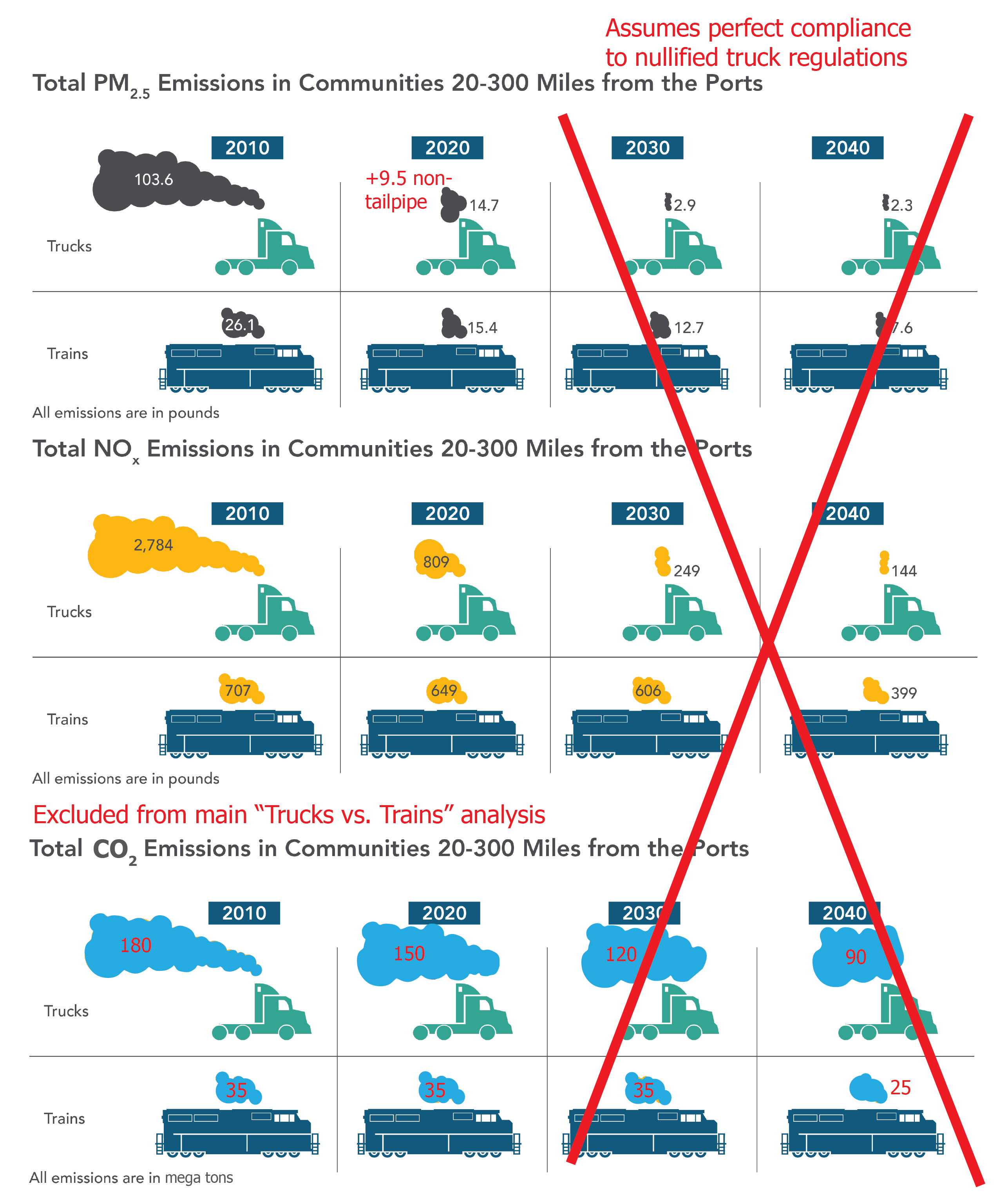Californians for Electric Rail has previously written about errors in the California Air Resources Board (CARB)'s public-facing materials and reports. Our latest whitepaper points out shortcomings in CARB's 2020 Trucks vs Trains Analysis.

In 2020, CARB published a Trucks vs. Trains Analysis calculating the impacts of in-progress truck regulations on relative emissions between the truck and rail freight sectors. Importantly, these analyses assumed perfect compliance with CARB’s Advanced Clean Trucks and Advanced Clean Fleets Rules, and no regulation or zero-emissions transition in the rail sector. These purported to show that trucks would be cleaner than trains in the then near future year of 2023 if no rail regulations were put in place. It’s no surprise that if you assume one sector transitions to zero emissions and the other doesn’t, your results will show lower emissions in the one that transitioned.
However, in 2025 none of these assumptions are true. CARB proposed the In-Use Locomotive Rule regulating rail emissions in 2022, and as of 2025 all three regulations have been nullified by the Trump administration. Meanwhile, CARB’s analysis has been taken out of context to argue against vehicle miles travelled (VMT) reduction or modal shift to rail in the freight sector. Major policy directions like this need to be based on real-world data, not outmoded assumptions. In addition to being highly tailored to now-irrelevant regulations, CARB’s analysis omits many key impacts from trucks and completely ignores greenhouse gas emissions.
CARB modeled the air quality impacts of a single freight train consist traveling 300 miles from a port, and the equivalent capacity in trucks based on assumptions about the fleet composition that change over time. CARB’s analyses showed that in 2020, trains had lower smog-forming NOx emissions than the equivalent in trucks, while cancer-causing PM2.5 emissions were less than 5% higher for rail between 20-300 miles of ports. However, they project dramatic, immediate drops in truck emissions in 2023 following the onset of trucking regulations. Unfortunately, this expected rapid drop in truck emissions does not hold up to reality. While CARB has touted that 6% of medium and heavy duty vehicles sold in 2023 were zero-emission, the overwhelming majority of these were buses and last-mile delivery vehicles, not heavy-duty trucks that compete with rail. Nationally 0.4% of heavy-duty trucks registered in 2024 were zero emission, far less than the 5% required by CARB’s now-defunct truck regulations. Given that the truck zero emissions transition is not proceeding as planned and may be further jeopardized by the Trump Administration, the 2020 analysis is a more realistic comparison for 2025.
CARB’s analyses completely ignore non-tailpipe emissions (tire, brake, and pavement particulate matter), which are substantially higher for trucks and may be worsened by the zero-emissions transition. Trains do not produce tire or pavement particulate emissions, and CARB’s own calculations (not included in the main report) suggest including non-tailpipe emissions would increase their calculated truck PM2.5 emissions by 60% prior to 2023. Including these emissions, pre-regulation truck emissions were almost certainly higher than trains for both PM2.5 and NOx.
CARB’s main analysis ignores greenhouse gas emissions and the fact that trains are at least three times more energy efficient than trucks per ton-mile moved – part of a pattern of siloing air quality and greenhouse gases that has resulted in the rampant promotion of fossil hydrogen vehicles. However, a supplementary analysis of greenhouse gas emissions shows that trains, even with little zero emissions adoption, are cleaner than trucks, unless the trucks are 100% ZE, which is unlikely to happen for decades. Thus, maintaining or improving rail freight mode share is critical for short term greenhouse gas emissions reduction, especially given the hurdles facing zero emissions trucks.
Ultimately, the solution is both electric trucks and electric trains. But the far greater energy efficiency of rail reduces the second-order environmental and social impacts of the zero-emissions transition (e.g. embodied manufacturing emissions and electric power demand). And overhead catenary rail is the proven zero-emissions technology for heavy freight.
CARB’s analysis only examined line-haul freight, and has nothing to say on rail yards, which have long been identified as nexuses for pollution. Targeted investments in rail yard emissions reduction are complementary with rail mode shift and could be achieved more rapidly than total decarbonization of the entire network.
Air pollution and climate change shouldn’t be treated as unrelated problems when they have a common cause, burning fossil fuels, and a common solution: electric rail. While it is important to reduce all sources of emissions, a closer look at the portions of CARB’s analysis not resting on debunked assumptions shows rail is the cleaner way to transport freight today. Modal shift to rail for freight would result in better air quality, lower greenhouse gas emissions, and safer and better roads, and supports the ultimate electrification of our railways. We urge CARB to prioritize both rail modal shift and overhead electrification in future policymaking related to the freight sector.
For more detailed analysis and references, read the full whitepaper.